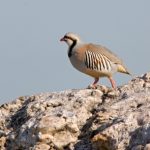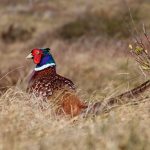This update to our 2021 Upland Gamebird Hunting Forecast incorporates the results of late summer upland bird population surveys. This data measures recruitment of birds into the fall population, providing a more finely tuned forecast than was possible at press time for the magazine in mid-July. Read the full article here.
The boom-and-bust cycle is part of the allure of upland gamebird hunting, and it is truly a double-edged sword.
Starting with even modest numbers, favorable weather patterns can spur an explosion that leads to a spectacular campaign like what transpired for pheasants and prairie grouse across a good swath of their range in 2020. Hunters harvested an estimated 67,261 sharp-tailed grouse and greater prairie chickens last fall in South Dakota, more than double that of the previous season and the highest total in 20 years! Those that elected to stay at home, lulled to inaction by what seemed to be a middling population, missed a remarkable season. It was the same general story for bobwhite quail in portions of South Texas; pheasants in South Dakota, Iowa, and Nebraska; and sharptails in Montana – mediocre in 2019, lights out in 2020. Lesson learned: When in doubt, load up the bird dogs and go hunting!
The flip side is that things can go south in a hurry. In good years, young birds often comprise two-thirds or more of the harvest, which means that the current year’s production plays a major role in the fall population. Adverse weather conditions during spring or summer can wipe out much of that year’s crop of young birds. This type of bust, even coming off a boom year, can dramatically reduce gamebird populations.
That’s why we tune up our Upland Gamebird Hunting Forecast prediction about this time each year by incorporating the results of roadside and brood surveys conducted by some of the state wildlife agencies in late summer. Lots can change between mid-July and late September, particularly in the face of an historic drought. This year we go heavy on pheasants, prairie grouse, and bobwhites due to the intrigue around the impacts of the epic drought that gripped much of the West and the Great Plains this summer.
So, what’s the 2021 picture? In short, it’s a mixed bag. Winter was exceedingly mild, spring weather was good in many places, and summer rains yielded excellent habitat conditions in some regions. However, the promise of back-to-back boom years largely evaporated with the devastating drought. Nevertheless, there will be very good upland bird hunting in many locations across the nation’s heartland. A resounding drought-based theme of this update is that survey results varied significantly within states and even within regions of states, a function of rainfall patterns. It’s the year to be adaptable and do your homework.
Quick Links
Sharptails, Huns, and Prairie Chickens
Pheasants
In Iowa, the numbers are in, and they tell an exciting story about the upcoming season in the Hawkeye State! The roadside survey revealed a statewide pheasant index of 20.1 birds per route, almost identical to last year and 21 percent above the 10-year trend, according to Todd Bogenschutz, Iowa DNR. The highest pheasant densities were in the North Central (32 birds per route), West Central (32 birds), Northwest (30 birds), and Central (26 birds) regions – the first time three regions boasted 30-plus birds per route since 2007. And here’s the kicker: The increase in the North Central and Central regions was statistically significant, and those regions yielded large increases in numbers of chicks observed, 37 percent and 33 percent, respectively. Think about hunting where pheasant recruitment was good, and these regions fit the bill!
Bogenschutz predicts hunters will harvest between 250,00-350,000 pheasants this fall, noting that numbers will likely be higher than last year in some regions. “Given the information, our weather model is predicting the pheasant population will be unchanged to slightly higher in 2021. I expect there to be regional differences given the weather – populations might be up quite a bit in northwestern part of Iowa, but likely quite a bit lower in the southeastern part of the state. With winter ice reported across much of southern Iowa, I expect quail numbers will be lower than last year.” These times are truly approaching the good old days of twenty years ago in Iowa pheasant lore.
South Dakota will unquestionably lead the nation in pheasant harvest again this year coming off a banner 2020 season in which hunters tallied a staggering 1.1 million pheasants, a 33 percent increase from the previous season! Will it be that good again in 2021? That’s hard to say since the South Dakota Game, Fish & Parks discontinued their long tradition of conducting August roadside surveys last year. However, in some ways it doesn’t really matter because South Dakota boasts incredible pheasant populations, and ringneck hunters who put in the boot-miles will be successful. Here’s what we do know: Winter was exceedingly mild, which obviously carried lots of adult birds into this year’s population; drought hammered much of the state this summer, likely adversely impacting pheasant recruitment; fall harvest is slated to be early, which helps hunting success; and habitat work is on the upswing statewide due to new and expanded conservation programs. Finally, according to the U.S. Drought Monitor, northeastern and, to a lesser degree, southeastern SoDak escaped the worst drought conditions with portions of those regions registering abnormally dry or moderate drought for much of July and August when the rest of the state was largely in severe and extreme drought. Might be worth a look. My advice: Make your own prediction (mine is a harvest of 950,000 pheasants) and go hunt roosters in South Dakota!
In Kansas, the summer brood surveys showed a slight decline from last year, according to Kansas Department of Wildlife, Parks and Tourism. However, that doesn’t tell the full story, says Jeff Prendergast, Kansas DWPT, noting that summer survey conditions weren’t ideal: “Both the percent of hens with chicks and the total brood size were up this year, which serve as indicators of good production. The disparity between the increased estimates of production and the decreased overall observations may be related to survey conditions.” This is indicative that the population may be higher than what was reported. Further, the real story is what transpired in far western Kansas. The Northern High Plains region (northwest Kansas) had the highest overall pheasant densities in the state and the southwestern portion of that region was phenomenal. Scott, Greeley, and Sherman counties saw whopping increases of 48 percent, 129 percent, and 206 percent, respectively and represent three of the four highest county-level densities in the state. Likewise, the far western portions of the Southern High Plains region (southwest Kansas) including Hamilton, Kearney, Stanton, and Morton counties saw similar spikes. The most compelling reason to give western Kansas a look this season, though, is the extraordinarily high ratios of young birds – a 7.5 chicks-to-adult ratio in the Northern High Plains and an exceptional 9.1 ratio in the Southern High Plains. Again, think about the difference between hunting young birds and wily old roosters!
Minnesota was coming off a very good year in which the population greatly expanded in 2020 in the southwestern pheasant stronghold, but the drought adversely impacted production this year. The 2021 statewide range-wide pheasant index (40.7 birds per 100 miles) decreased 25% from 2020 and is similar to the 10-year average, according to Timothy Lyons, Minnesota Department of Natural Resources (DNR). “Weather conditions overwinter and during the early nesting season were very favorable, but widespread drought may have adversely affected nesting or brood rearing conditions. Regionally, pheasants declined in all but the Southeast region.” Nevertheless, Lyons reports that the core pheasant range (West Central, Southwest, and South Central regions) indices were similar to or greater than their respective 10-year averages.
In Nebraska, the surveys revealed a 14 percent decline statewide from last year in the July Rural Marrier Survey, according to the Nebraska Game, Fish & Parks. The state’s two best regions for pheasants – the Panhandle and Southwest – declined by 7 percent and 45 percent, respectively, largely a function of drought. However, there’s some good news for Nebraska hunters in that the close-to-home opportunities for most of the state’s residents are trending up. This spring’s crow counts were up 29 percent and 35 percent in the Northeast and Southeast regions. The summer surveys revealed the Northeast region pheasant numbers were identical to last year, indicative of back-to-back years of good production, and equal to the 5-year average. Nevertheless, the Panhandle and Southwest will still offer the best array of habitat and the highest pheasant numbers in the state.
North Dakota was hit hard by the drought this summer, and the brood survey results reveal a 23 percent decline in pheasant numbers statewide, according to Jesse Kolar of North Dakota Game, Fish and Parks. However, the pheasant population spiked last year due to ideal conditions in 2020, so it is important to keep this year’s downturn in context. Further, the two regions of the state with the best pheasant populations – Northwest and Southwest – fared reasonably well. The survey revealed 68 pheasants per 100 miles in the Northwest region, down from 80 last year. Likewise, the Southwest region counts declined only slightly to 59 this year from 65 last year. Slightly fewer broods were observed, but the average brood size was an encouraging six in the Northwest and seven in the Southwest. Kolar notes that due to the exceptional drought across much of the state this summer there will be fewer acres of typical grassland cover to walk, but hunters should find similar bird numbers as last year.
In Montana, the state does not conduct summer surveys, but Montana Fish Wildlife and Parks expects pheasant numbers will be lower across the Hi-Line of northern Montana due to this summer’s drought, a prediction that matches my observations while hunting sharptails and Huns in September.
SHARPTAILS, HUNS, AND PRAIRIE CHICKENS
Last year will go down in history as one of the best seasons in recent memory for sharptailed-grouse and prairie chicken hunters in South Dakota, North Dakota, and Montana. The 2020 weather was optimal and prairie grouse populations exploded! A mild winter had many of us licking our chops in anticipation of the remarkable numbers that could have materialized with another ideal spring and summer. Those lofty dreams fell victim to the drought, but the good news is that the high carryover of adult birds and some scattered summer rains produced good grouse numbers in some regions.
In North Dakota, the summer brood survey revealed a 2 percent statewide increase in sharptail populations with an average of 19 sharptails observed per 100 miles. Given last year’s stellar recruitment, grouse populations holding steady through a severe drought is great news for sharptail hunters. Furthermore, average brood size was six, up from five last year. Kolar reports that sharptail populations are still well above the long-term average in the Missouri River country and that hunters should find plenty of birds in the good regions of western and central North Dakota. The trick, he says, will be adapting hunting techniques. “Many rangelands that hold grouse on an average year will be too open to hunt this fall, and most grouse will likely be found in shrubland, woodland draws, and/or near riparian areas.”
South Dakota and Montana don’t conduct summer grouse surveys but both states predict that prairie grouse numbers will decline from the epic fall of 2020. In Montana, sharptail numbers were above the long-term average in portions of the northeastern region coming into the spring, but the severe drought adversely impacted recruitment in most areas, according to Montana Fish, Wildlife and Parks. Likewise, southeastern Montana was very dry and will likely yield lower sharptail numbers.
In South Dakota, prairie grouse came into the spring in great shape with very high numbers on leks. However, the weather in June was extremely hot and dry which is negatively correlated with prairie grouse recruitment, explained Travis Runia, South Dakota GFP. “Our analysis of data dating back to 1994 suggests that abnormally warm June weather can be a detriment to grouse production, potentially caused by reduced insect production, deteriorating habitat conditions related to drought, or chick loss from heat stress. The average June temperature in central South Dakota this year was about 6.3 degrees above normal, the warmest in the last 30 years and the seventh warmest since 1895. It was also the driest June on record which resulted in drought conditions.” Nevertheless, given the boom of 2020, if hunters can find localized pockets that received June rainfall, there will likely be some good hunting available.
Huns may be the bright spot in the northern Great Plains. In North Dakota, Huns were up 9 percent statewide following a massive increase of 45 percent last year. Most partridge harvest occurs incidental to sharptails or pheasants, but North Dakota’s Hun numbers are starting to add up to something meaningful. Surveys revealed 10 Huns observed per 100 miles, compared to 19 sharptails, and average brood size this year was 10 Huns. That’s respectable. Albeit without any hard data, the pattern seems to be similar in northeastern Montana, though massive CRP losses have wiped out lots of partridge habitat. Lastly, in Idaho, look for decent numbers of Huns in the Southwest region where spring and summer weather patterns were good-to-excellent for all upland gamebirds, according to the Idaho Department of Fish and Game.
BOBWHITE QUAIL
The bobwhite picture ranges from exceedingly bleak looking at the data alone to behind-the-curtains optimistic, and, overall, a bit fuzzy due to survey condition issues.
Starting with the perplexing and mildly optimistic, Kansas quail numbers declined by 21 percent despite excellent carryover from last year and reasonably good weather conditions this summer. That’s the short story. One of the Nation’s leading quail experts, Jeff Prendergast, Kansas DWPT, provides the long version. “We had above-average spring precipitation across much of the state, resulting in good nesting habitat. Summer transitioned into a hotter and drier period which had the potential to impact chick survival. However, Kansas received enough rainfall throughout the summer to stay relatively drought free. This paired with ample insects and cover produced from spring moisture appears to have sustained chicks as production indices were improved. Despite the improved production, the brood survey estimated a decrease in the statewide densities of quail fueled largely by large decreases in estimates in the Smoky Hills. Disagreement between these estimates and the estimates of production may suggest poor survey conditions impacted counts. Kansas maintains one of the premier quail populations paired with abundant access, so harvest will again be among the highest in the country.”
Muddy for sure, but there’s plenty of encouraging news. Bobwhite densities were highest in the Flint Hills this year, fueled by a 14 percent increase that followed a major spike last year. Likewise, good hunting will be available in the South-Central Prairies and Southern High Plains region, including Hamilton County where quail survey results doubled from last year and were the highest in the state this summer. In the Smoky Hills, a Kansas quail stronghold, the counts declined by 46 percent but, as Prendergast noted, some of that could have been related to survey conditions.
Iowa and Nebraska are a lot more clear-cut. According to Bogenschutz, Iowa’s statewide bobwhite quail index fell to 0.38 birds per route, a statistically significant decline from last year’s index of 0.74 birds per route, and now 58 percent below the 10-year average. This represents the fifth lowest quail index in 60 years of the roadside surveys. Likewise, in Nebraska, quail numbers declined by 22 percent statewide as measured the July Rural Mail Carrier Survey results, according to Nebraska GFP. Quail populations in Nebraska are currently 35 percent below the 5-year average.
In Oklahoma, the August roadside quail survey showed the statewide quail index down slightly from 2020, dropping from 1.68 to 1.56, which is 70 percent below the 32-year average, says Tell Judkins, Oklahoma Department of Wildlife Conservation. However, the index for Oklahoma’s two best traditional quail regions – Southwest (2.66) and Northwest (2.88) – was improved from last year, but still down dramatically from the 10-year average. Judkins encourages hunters to sit tight on Oklahoma. “Anecdotally, I have received numerous brood reports over late-August and early-September. Over the 32 years of the roadside surveys the August surveys have shown they are not always the most reliable when it comes to forecasting the season. As with all roadside surveys with such a small sample size, even a tiny change in bird observations can show up as a huge shift in a route’s data. Stay tuned for the October roadside surveys, which will provide a better indication of what the upcoming quail season could have in store.”
Finally, the survey results from Texas, the granddaddy of all bobwhite states and nation’s leader in harvest in most years, is shockingly bleak. However, there’s more to the story than meets the eye relative to South Texas – so take note, bobwhite hunters!
First the data: The average number of bobwhites observed per route in the Rolling Plains and South Texas regions were the lowest since the survey’s inception in 1978, reported John McLaughlin, Texas Parks and Wildlife Department. In the Rolling Plains, the survey result of 1.50 bobwhites per route was a tiny fraction of the 15-year mean of 13.44 and was even lower than the dismal 3.25 bobwhites per route observed in 2020. This disappointing news makes sense, though, given that quail numbers have been very low for three years and the weather this early spring was dry and habitat conditions were poor. In South Texas, coming off a pretty good hunting season and blessed with excellent weather conditions, the counts dipped to a perplexing 3.10 birds per route from 3.77 birds per route in 2020, well below the 15-year average of 9.13 birds.
The puzzle is a complicated by the fact that in May the rains returned to Texas and the rest of the summer was marked by good rainfall and cool temperatures that produced lush vegetation and ideal conditions for quail reproduction. It is possible that the breeding population was so low coming into the season that quail couldn’t take advantage of the optimum summer conditions. It’s also conceivable that the abundant grass and forbs masked, to some degree, the detectability of quail on the survey. Nevertheless, habitat conditions are set up well for a bounce-back year in 2022.
Now, for the interesting piece, McLaughlin provides excellent insight on South Texas. “Hunting prospects in South Texas are much more promising, mirroring a scenario we witnessed play out last year. Despite low survey numbers following a good year of reproduction, the region accounted for about 80% of the estimated 315,872 bobwhites harvested statewide last year. Early reports suggest bobwhite populations in the region were buoyed by spring and summer rainfall and most expect populations and harvest will once again outperform our survey estimates. The reports are especially promising for those areas east of I-35 and particularly for the region known as the sand sheet including Brooks and Kenedy counties. Notably, while habitat conditions are typically drying up in August, our biologists reported the region was as green as they’d ever seen it during our survey period. We expect above average to very good hunting in this part of South Texas. The areas west of I-35 to Del Rio are also expecting above average, good hunting. While those counties didn’t receive as much rainfall across the board, conditions throughout the summer were favorable for bobwhites. There will be exceptions throughout the region but there’s plenty of reason to be excited about quail hunting in South Texas this year.”
CHUKARS
The extreme drought conditions that hammered the Intermountain West this summer, at first glance, would make chukar hunting this fall and winter seem like an exercise in futility. However, the Nevada Department of Wildlife’s consistent effort to measure chukar populations through their annual summer surveys shed some light that suggests there are viable options for getting into good chukar hunting in the rimrock canyons on bright blue winter days.
The calculated statewide average production value was 2.3 chicks per adult, which is an improvement over the 1.7 chicks per adult observed last fall. While the statewide index is still considered low for maintaining sustainable populations, there are some bright lights in northern Nevada. Shawn Espinosa, Nevada DOW, reports that chukar populations had improved productivity in portions of northeastern Nevada such as the Bruneau River country and the Snowstorm Range which should provide better hunting opportunities this season. Likewise, the Shoshone Range in Lander County, portions of western Pershing County, and mountain ranges in Humboldt County such as the Black Rocks, Jacksons and Pine Forest should continue to provide decent opportunities for chukar hunters. All in all, it won’t be an epic year for chukars, but Nevada will be better than it would have seemed by watching the relentless television coverage of the droughts in the West.
Finally, In Idaho, as described above for Huns, the Southwest region should provide some good chukar hunting, according to Idaho DFG, particularly in localized areas where over-winter survival was high. However, the chukar picture in the Clearwater Region is fuzzy due to the potential impacts of summer drought conditions.






